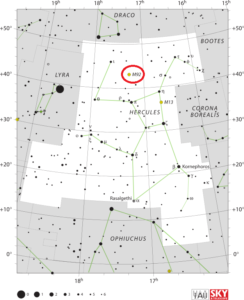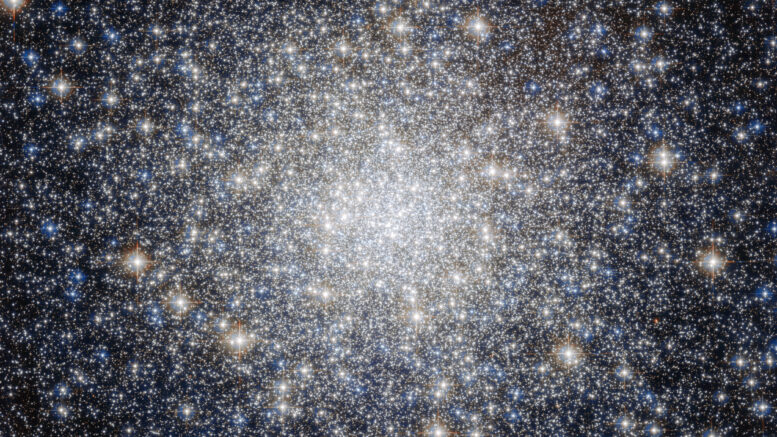Messier 92 is a globular cluster located in the northern constellation Hercules. Messier 92 is one of the brighter northern globulars – both visually and in terms of absolute magnitude – and can be seen without binoculars under good conditions. With an estimated age of 14.2 billion years – almost the same age as the universe itself – M92 is one of the oldest clusters known and possibly the single oldest globular in the Milky Way.
| Description | |
| Visible From Pacific Northwest | March To September |
| Best Time To Observe | July |
| Minimum Size Of Viewing Device | 10×50 binoculars |
| Object Type | Globular Cluster |
| Designations | Messier 92, M92, NGC 6341, C 1715+432, GCl 59, MWSC 2557 |
| Right Ascension | 17h 17m 07.39s |
| Declination | +43°08’09.4” |
| Constellation | Hercules |
| Number Of Stars | 250,000 |
| Apparent magnitude | +6.3 |
| Apparent dimensions | 14′ |
| Object Radius | 54.5 light years |
| Distance From Earth | 26,700 light years |
History
Messier 92 was discovered by the German astronomer Johann Elert Bode on December 27, 1777. Bode described the object as a “nebula. More or less round with pale glow.”
Charles Messier independently discovered the cluster and catalogued it on March 18, 1781, along with eight galaxies in the Virgo Cluster, which are located in the constellations Virgo and Coma Berenices
William Herschel was the first to resolve the cluster into stars using a 7-foot telescope in 1783.
John Herschel added the cluster to his General Catalogue as GC 4294. He described it as a “globular cluster; very bright; very large; extremely compressed toward the middle; well resolved; small stars.”
Locating M92 In The Sky
Messier 92 occupies an area of 14 arc minutes of apparent sky, which corresponds to a linear extension of 109 light years. It is positioned north of the Keystone asterism in Hercules, between the Keystone star Eta Herculis and Iota Herculis. The cluster lies about 60 percent of the way from Eta to Iota. It forms a triangle with the two northernmost stars of the Keystone, Eta and Pi Herculis, which form the widest part of the asterism.
M92 can also be found by first locating the bright Etamin (Eltanin, Gamma Draconis), an orange giant in Draco, and then moving about 6 degrees in the direction of the Keystone.

Viewing M92
In 10×50 binoculars, M92 appears like a blurry star with a brighter core. Small and medium-sized telescopes will resolve some of the stars in the outer regions of the cluster. 6-inch and 8-inch telescopes show an oval-shaped cluster with a bright centre, surrounded by a halo of stars. 12-inch telescopes resolve dozens of individual stars in the halo and throughout the cluster. The best time of year to observe M92 is during the summer, when Hercules is high overhead in the evening for northern observers.
Photographing M92
It is not as popular a target for amateur astronomers as the brighter and larger M13 Hercules Cluster, which lies in the vicinity. M92 has a much denser core and is more difficult to resolve than M13.
Beautiful photos have been taken with less than 2 hours of exposure, with that exposure spread over different ISO and different exposures. Autoguiding is required as clusters need to be accurate so the stars remain crisp.
https://www.cloudynights.com/topic/502811-m92-a-beautiful-globular/
https://www.cloudynights.com/topic/471526-globular-cluster-messier-92/
Sources And Further Reading
Descriptions of all of Messier Objects can be found here.
https://www.nasa.gov/feature/goddard/2017/messier-92
http://www.messier.seds.org/m/m092.html

Be the first to comment on "Messier 92"